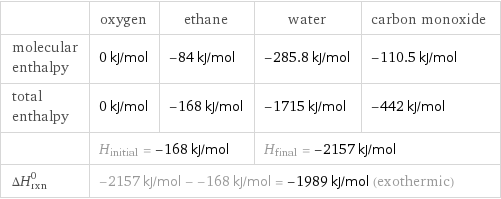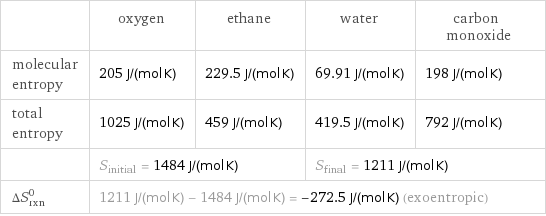Input interpretation

O_2 oxygen + CH_3CH_3 ethane ⟶ H_2O water + CO carbon monoxide
Balanced equation

Balance the chemical equation algebraically: O_2 + CH_3CH_3 ⟶ H_2O + CO Add stoichiometric coefficients, c_i, to the reactants and products: c_1 O_2 + c_2 CH_3CH_3 ⟶ c_3 H_2O + c_4 CO Set the number of atoms in the reactants equal to the number of atoms in the products for O, C and H: O: | 2 c_1 = c_3 + c_4 C: | 2 c_2 = c_4 H: | 6 c_2 = 2 c_3 Since the coefficients are relative quantities and underdetermined, choose a coefficient to set arbitrarily. To keep the coefficients small, the arbitrary value is ordinarily one. For instance, set c_2 = 1 and solve the system of equations for the remaining coefficients: c_1 = 5/2 c_2 = 1 c_3 = 3 c_4 = 2 Multiply by the least common denominator, 2, to eliminate fractional coefficients: c_1 = 5 c_2 = 2 c_3 = 6 c_4 = 4 Substitute the coefficients into the chemical reaction to obtain the balanced equation: Answer: | | 5 O_2 + 2 CH_3CH_3 ⟶ 6 H_2O + 4 CO
Structures

+ ⟶ +
Names

oxygen + ethane ⟶ water + carbon monoxide
Reaction thermodynamics
Enthalpy

| oxygen | ethane | water | carbon monoxide molecular enthalpy | 0 kJ/mol | -84 kJ/mol | -285.8 kJ/mol | -110.5 kJ/mol total enthalpy | 0 kJ/mol | -168 kJ/mol | -1715 kJ/mol | -442 kJ/mol | H_initial = -168 kJ/mol | | H_final = -2157 kJ/mol | ΔH_rxn^0 | -2157 kJ/mol - -168 kJ/mol = -1989 kJ/mol (exothermic) | | |
Gibbs free energy

| oxygen | ethane | water | carbon monoxide molecular free energy | 231.7 kJ/mol | -32 kJ/mol | -237.1 kJ/mol | -137 kJ/mol total free energy | 1159 kJ/mol | -64 kJ/mol | -1423 kJ/mol | -548 kJ/mol | G_initial = 1095 kJ/mol | | G_final = -1971 kJ/mol | ΔG_rxn^0 | -1971 kJ/mol - 1095 kJ/mol = -3065 kJ/mol (exergonic) | | |
Entropy

| oxygen | ethane | water | carbon monoxide molecular entropy | 205 J/(mol K) | 229.5 J/(mol K) | 69.91 J/(mol K) | 198 J/(mol K) total entropy | 1025 J/(mol K) | 459 J/(mol K) | 419.5 J/(mol K) | 792 J/(mol K) | S_initial = 1484 J/(mol K) | | S_final = 1211 J/(mol K) | ΔS_rxn^0 | 1211 J/(mol K) - 1484 J/(mol K) = -272.5 J/(mol K) (exoentropic) | | |
Equilibrium constant
![Construct the equilibrium constant, K, expression for: O_2 + CH_3CH_3 ⟶ H_2O + CO Plan: • Balance the chemical equation. • Determine the stoichiometric numbers. • Assemble the activity expression for each chemical species. • Use the activity expressions to build the equilibrium constant expression. Write the balanced chemical equation: 5 O_2 + 2 CH_3CH_3 ⟶ 6 H_2O + 4 CO Assign stoichiometric numbers, ν_i, using the stoichiometric coefficients, c_i, from the balanced chemical equation in the following manner: ν_i = -c_i for reactants and ν_i = c_i for products: chemical species | c_i | ν_i O_2 | 5 | -5 CH_3CH_3 | 2 | -2 H_2O | 6 | 6 CO | 4 | 4 Assemble the activity expressions accounting for the state of matter and ν_i: chemical species | c_i | ν_i | activity expression O_2 | 5 | -5 | ([O2])^(-5) CH_3CH_3 | 2 | -2 | ([CH3CH3])^(-2) H_2O | 6 | 6 | ([H2O])^6 CO | 4 | 4 | ([CO])^4 The equilibrium constant symbol in the concentration basis is: K_c Mulitply the activity expressions to arrive at the K_c expression: Answer: | | K_c = ([O2])^(-5) ([CH3CH3])^(-2) ([H2O])^6 ([CO])^4 = (([H2O])^6 ([CO])^4)/(([O2])^5 ([CH3CH3])^2)](../image_source/30c274c6a77e42297e4d4a51104654ef.png)
Construct the equilibrium constant, K, expression for: O_2 + CH_3CH_3 ⟶ H_2O + CO Plan: • Balance the chemical equation. • Determine the stoichiometric numbers. • Assemble the activity expression for each chemical species. • Use the activity expressions to build the equilibrium constant expression. Write the balanced chemical equation: 5 O_2 + 2 CH_3CH_3 ⟶ 6 H_2O + 4 CO Assign stoichiometric numbers, ν_i, using the stoichiometric coefficients, c_i, from the balanced chemical equation in the following manner: ν_i = -c_i for reactants and ν_i = c_i for products: chemical species | c_i | ν_i O_2 | 5 | -5 CH_3CH_3 | 2 | -2 H_2O | 6 | 6 CO | 4 | 4 Assemble the activity expressions accounting for the state of matter and ν_i: chemical species | c_i | ν_i | activity expression O_2 | 5 | -5 | ([O2])^(-5) CH_3CH_3 | 2 | -2 | ([CH3CH3])^(-2) H_2O | 6 | 6 | ([H2O])^6 CO | 4 | 4 | ([CO])^4 The equilibrium constant symbol in the concentration basis is: K_c Mulitply the activity expressions to arrive at the K_c expression: Answer: | | K_c = ([O2])^(-5) ([CH3CH3])^(-2) ([H2O])^6 ([CO])^4 = (([H2O])^6 ([CO])^4)/(([O2])^5 ([CH3CH3])^2)
Rate of reaction
![Construct the rate of reaction expression for: O_2 + CH_3CH_3 ⟶ H_2O + CO Plan: • Balance the chemical equation. • Determine the stoichiometric numbers. • Assemble the rate term for each chemical species. • Write the rate of reaction expression. Write the balanced chemical equation: 5 O_2 + 2 CH_3CH_3 ⟶ 6 H_2O + 4 CO Assign stoichiometric numbers, ν_i, using the stoichiometric coefficients, c_i, from the balanced chemical equation in the following manner: ν_i = -c_i for reactants and ν_i = c_i for products: chemical species | c_i | ν_i O_2 | 5 | -5 CH_3CH_3 | 2 | -2 H_2O | 6 | 6 CO | 4 | 4 The rate term for each chemical species, B_i, is 1/ν_i(Δ[B_i])/(Δt) where [B_i] is the amount concentration and t is time: chemical species | c_i | ν_i | rate term O_2 | 5 | -5 | -1/5 (Δ[O2])/(Δt) CH_3CH_3 | 2 | -2 | -1/2 (Δ[CH3CH3])/(Δt) H_2O | 6 | 6 | 1/6 (Δ[H2O])/(Δt) CO | 4 | 4 | 1/4 (Δ[CO])/(Δt) (for infinitesimal rate of change, replace Δ with d) Set the rate terms equal to each other to arrive at the rate expression: Answer: | | rate = -1/5 (Δ[O2])/(Δt) = -1/2 (Δ[CH3CH3])/(Δt) = 1/6 (Δ[H2O])/(Δt) = 1/4 (Δ[CO])/(Δt) (assuming constant volume and no accumulation of intermediates or side products)](../image_source/d90ffef4a5a1acd95fd9c2271d860c6f.png)
Construct the rate of reaction expression for: O_2 + CH_3CH_3 ⟶ H_2O + CO Plan: • Balance the chemical equation. • Determine the stoichiometric numbers. • Assemble the rate term for each chemical species. • Write the rate of reaction expression. Write the balanced chemical equation: 5 O_2 + 2 CH_3CH_3 ⟶ 6 H_2O + 4 CO Assign stoichiometric numbers, ν_i, using the stoichiometric coefficients, c_i, from the balanced chemical equation in the following manner: ν_i = -c_i for reactants and ν_i = c_i for products: chemical species | c_i | ν_i O_2 | 5 | -5 CH_3CH_3 | 2 | -2 H_2O | 6 | 6 CO | 4 | 4 The rate term for each chemical species, B_i, is 1/ν_i(Δ[B_i])/(Δt) where [B_i] is the amount concentration and t is time: chemical species | c_i | ν_i | rate term O_2 | 5 | -5 | -1/5 (Δ[O2])/(Δt) CH_3CH_3 | 2 | -2 | -1/2 (Δ[CH3CH3])/(Δt) H_2O | 6 | 6 | 1/6 (Δ[H2O])/(Δt) CO | 4 | 4 | 1/4 (Δ[CO])/(Δt) (for infinitesimal rate of change, replace Δ with d) Set the rate terms equal to each other to arrive at the rate expression: Answer: | | rate = -1/5 (Δ[O2])/(Δt) = -1/2 (Δ[CH3CH3])/(Δt) = 1/6 (Δ[H2O])/(Δt) = 1/4 (Δ[CO])/(Δt) (assuming constant volume and no accumulation of intermediates or side products)
Chemical names and formulas

| oxygen | ethane | water | carbon monoxide formula | O_2 | CH_3CH_3 | H_2O | CO Hill formula | O_2 | C_2H_6 | H_2O | CO name | oxygen | ethane | water | carbon monoxide IUPAC name | molecular oxygen | ethane | water | carbon monoxide